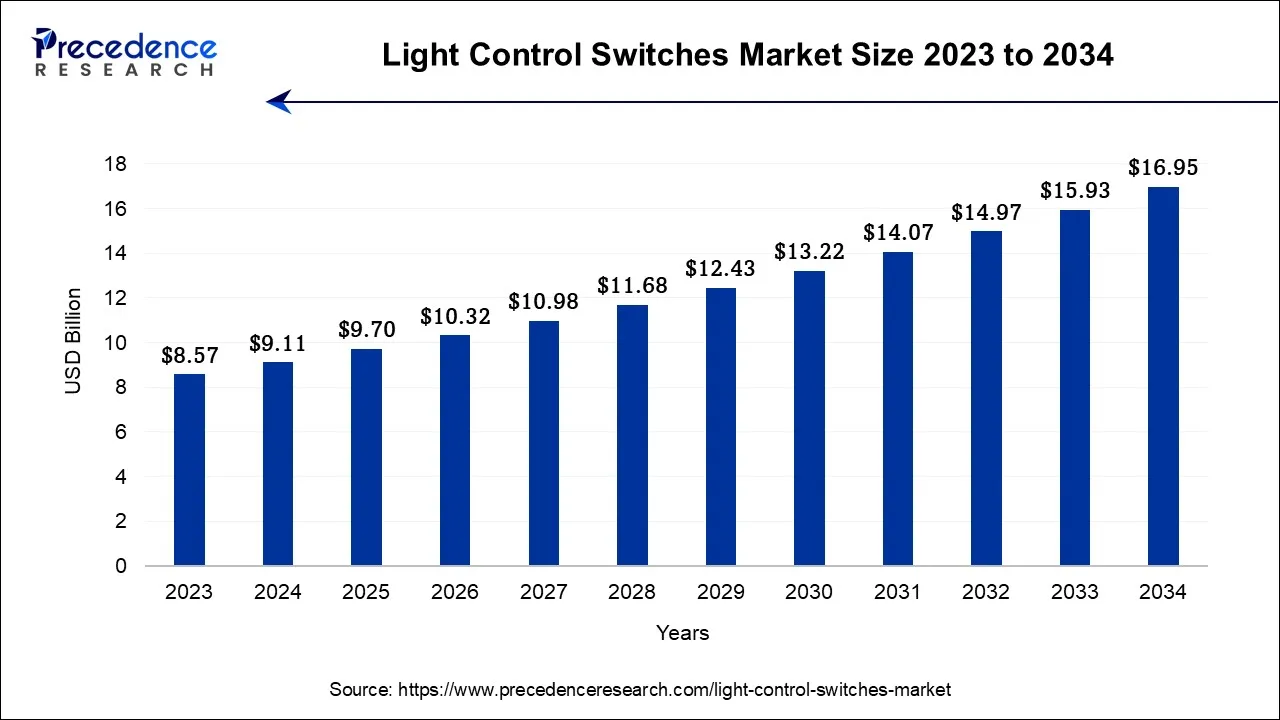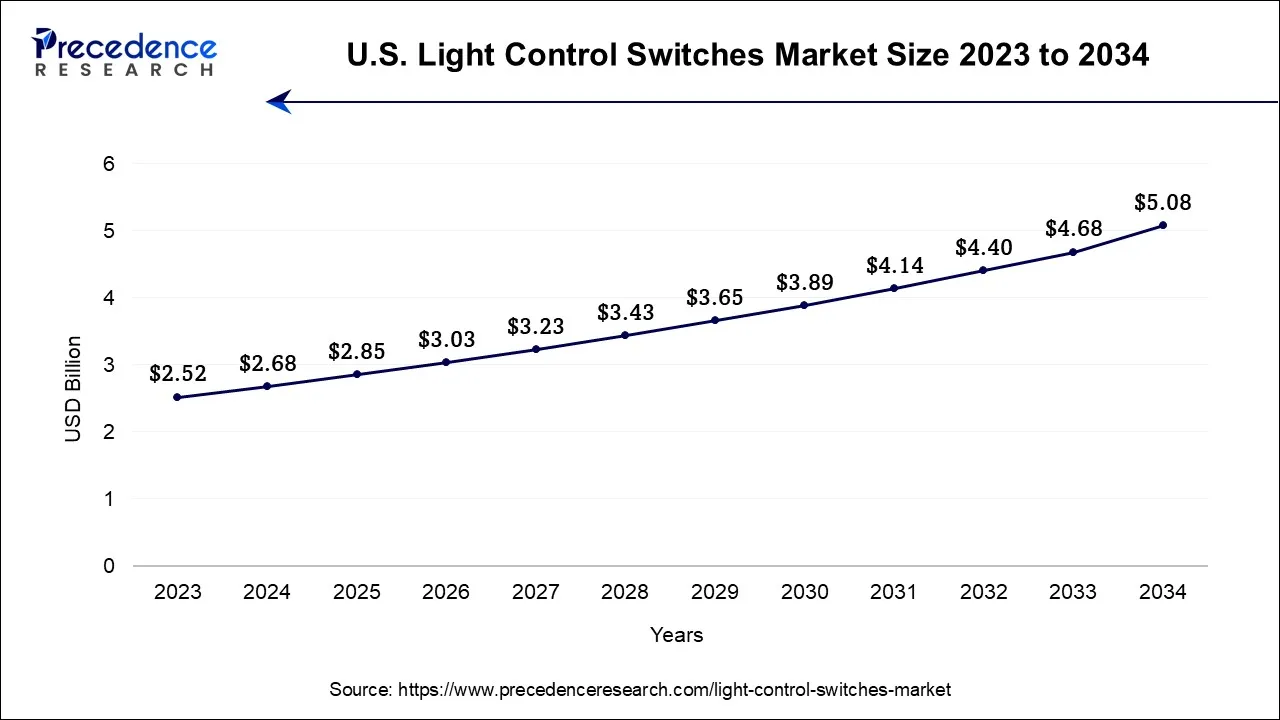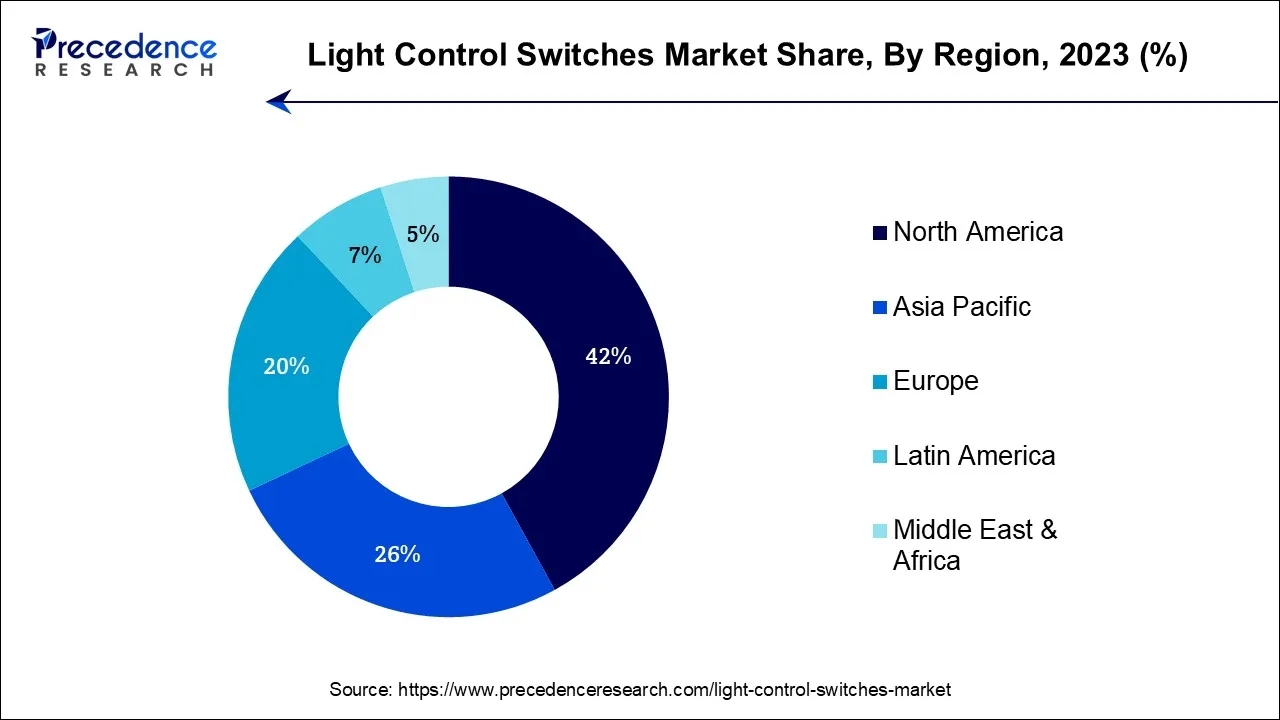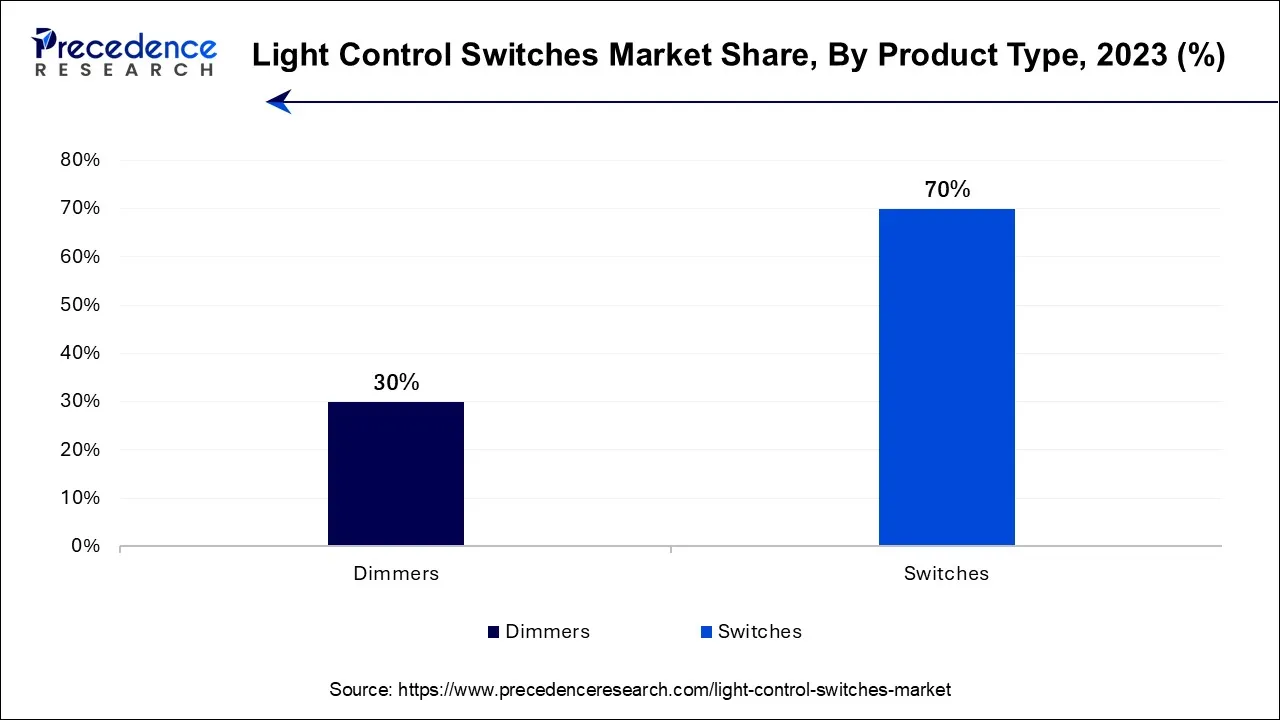March 2025
The global light control switches market size is calculated at USD 9.11 billion in 2024, grew to USD 9.70 billion in 2025, and is predicted to hit around USD 16.95 billion by 2034, poised to grow at a CAGR of 6.4% between 2024 and 2034. The North America light control switches market size accounted for USD 3.83 billion in 2024 and is anticipated to grow at the fastest CAGR of 6.53% during the forecast year.
The global light control switches market size is expected to be valued at USD 9.11 billion in 2024 and is anticipated to reach around USD 16.95 billion by 2034, expanding at a CAGR of 6.4% over the forecast period from 2024 to 2034.

The U.S. light control switches market size is accounted for USD 2.68 billion in 2024 and is projected to be worth around USD 5.08 billion by 2034, poised to grow at a CAGR of 6.61% from 2024 to 2034.

North America accounted for the largest share of the light control switches market in 2023; the region is anticipated to continue its growth during the forecast period. The North American light control switches market is characterized by the presence of key market players, key players are constantly innovating and expanding their product portfolios to meet evolving consumer demands. Factors such as technological advancements, high demand for smart homes, growing demand for energy-saving lighting systems, and rapid adoption of wireless communication technology such as ZigBee, have emerged with more popularity in recent years. The primary factor driving North America's lighting market growth is the growing adoption of LED lighting for energy-efficient lighting systems, increasing awareness regarding low power consumption, and the rising adoption of smart cities in North America. LED is an energy-efficient lighting technology the future of lighting in the United States. These lights utilize 75% less energy.
According to the data reported by the United States Department of Energy, most lighting installations are projected to use LED technology by 2035. Thereby, all these elements act as major drivers for the market’s expansion in North America.

Asia Pacific is the fastest-growing region for the light control switches market. Asia Pacific region is experiencing urbanization, with an increasing number of people moving to urban areas. The increasing number of highways and streets, rising demand for energy-efficient electric systems, increasing usage of LEDs and CFLs and a rise in smart city projects are observed to fuel the market’s growth during the projected period. China is among the largest producers, consumers, and exporters of LED lighting products, and with several favorable initiatives taken by them, assisting its market to move towards 100% LED lighting. The active participation of the government through rules and regulations regarding the installation of electric control switches in both residential and commercial establishments is anticipated to propel the demand for light control switches in the Asia Pacific market.
The global light control switches market revolves around the innovation, development and distribution of components and equipment used to manage or operate electric lights. Light control switches come in different varieties of models to meet diverse household needs. A light switch is used to control the flow of electricity to the lights. The basic purpose of a light switch is to turn the power ON and OFF to the light source. A light switch can easily be installed on a wall or ceiling, and it can be placed on a countertop or table. A light control switch is used to regulate the operation of electrical lights or other attached light-related equipment.
Light control switches are easy to install and offer extended service, safety, style, and convenience. Based on use, different varieties of light switches are available in the market. Multiple types of switches are used depending on the lights, such as push-button light switches, Toggle light switches, Rocker light switches, Single Pole light switches, Touch Light switches, proximity light switches, and more. Lighting control switches help to minimize energy costs, enhance comfort, assist in energy code compliance, and positively impact the environment.
A light control switch is used to turn the lights ON and OFF using a switch or adjust light output up and down using a dimmer. The key use of light control switches is to reduce energy costs and improve sustainability and provide flexibility to meet user visual needs.
The rising consumer inclination towards energy-efficient lighting systems, rising awareness towards reducing energy consumption, declining prices of LED (light emitting diode) products, rapid urbanization, widespread smartphone adoption, and modernization infrastructure are observed to boost the growth of the light switches market during the forecast period. Fluorescent and light emitting diode (LED) consume less electricity which drives the demand for light control switches across the globe. In addition, the rapid technological advancement in the electronics industry resulted in an increasing demand for Wi-Fi switches and remote switches, which are used to regulate lights remotely.
| Report Coverage | Details |
| Market Size in 2024 | USD 9.11 Billion |
| Market Size by 2034 | USD 16.95 Billion |
| Growth Rate from 2024 to 2034 | CAGR of 6.4% |
| Largest Market | North America |
| Base Year | 2023 |
| Forecast Period | 2024 to 2034 |
| Segments Covered | By Communication Technology, By Product Type, By Application, and By Light Source |
| Regions Covered | North America, Europe, Asia-Pacific, Latin America, and Middle East & Africa |
The rising demand for energy-efficient lighting solutions is expected to boost the growth of the market during the forecast period. A precise lighting system makes houses more secure and the interior attractive. Smart lighting systems bring elegant ambiance and energy efficiency to any residential complex. The use of light control switches reduces energy costs and offers flexibility to meet the visual requirements of the users. In today’s era, Light is a basic amenity around the world. There have been numerous transformations in the light industry due to the high prices of electricity as well as the growing demand for bright & low-intensity lights. Compact fluorescent lamps (CFL) and light emitting diode (LED) are energy-efficient lighting systems due to their low consumption of electricity, which leads to an increase in their demand, therefore driving the growth of the light control switches market during the forecast period.
Compact fluorescent lamps (CFL) and light-emitting diodes (LEDs) are the most energy-efficient lighting solutions and rapidly developing lighting technology around the world. The lighting control switches are added to LEDs to help reduce electricity wastage as well as encourage energy efficiency. Light emitting diode (LED) light bulbs provide better light quality, extended life, and are more durable. LED light positively impacts the environment as LEDs offer incredible energy efficiency. LEDs are much safer to use as they do not produce heat the same way as incandescent bulbs do. As per Warehouse-Lighting.com, a US-based manufacturer of lighting products, LEDs are projected to make up 87% of sources of lighting by 2030.
The lack of internet connectivity associated with implementing light control switches can hamper the growth of the market. The lack of internet connectivity in underdeveloped countries significantly the adoption of light control switches. The lack of internet connectivity may discourage some potential customers from adopting or investing in these technologies and reduce the sales of light control switches, which acts as a significant restraint for the market’s growth. In addition, the lack of awareness regarding the benefits associated with the light control switches is expected to obstruct the market’s growth.
The increasing adoption of wireless lighting and wireless communication technology is projected to offer lucrative opportunities for the growth of the market. Wireless technology is gaining popularity rapidly. Wireless communication enables technology such as ZigBee. Wireless lighting controls are capable of tracking both vehicle and human activity as well as assisting in directing vehicles to the closest parking area. Lighting controls, including motion sensors, are being widely used in street and traffic lighting controls.
The wireless technology segment held the largest share in 2023, with the growing technological advancements across the globe; the wireless segment is projected to maintain its dominance in the light control switches market. Wireless communication technology such as ZigBee. In recent years, ZigBee has been gaining popularity significantly. The increasing smart city projects globally are projected to offer demand for ZigBee-based lighting solutions for residential smart lighting. ZigBee is a smart home technology developed to enable low-cost, low-power wireless M2M and IoT networks. Zigbee is a protocol used to link smart devices such as plugs, lights, and smart locks to a home network. ZigBee is designed for low power consumption. On the other hand, the Wired communication technology segment is expected to witness a significant increase during the forecast period.
In 2023, the switches segment holds the largest share of the light control switches market. The rising safety and security concerns, especially in residential areas, are expected to propel the demand for light control switches. The ongoing development of electric infrastructure globally has resulted in increasing demand for light switches. Not only lighting up the room but also some light switches offer special features which include light motion detectors to make moving around in the home safer and more convenient. A light switch is used to control the flow of electricity which opens or closes an electrical current to turn on a light fixture, ceiling fan, or any other similar electrical device.

On the other hand, Dimmers is expected to grow at a significant CAGR. Dimmer makes it easy to adjust the level of brightness and change the lighting moods. Dimmer provides energy consumption, flexible lighting options, and long-life of light bulbs. Several dimmers are rated for dimmable energy consumption saving bulbs such as CFL and LED bulbs.
The residential segment is the leading segment of the market; the rapid urbanization and rising demand from the residential sector in developing countries are anticipated to grow the demand for light control switch systems during the forecast period. On the other hand, the commercial end-user segment is expected to witness a noticeable rate during the forecast period. Commercial places such as malls, offices, retail shops, and others require energy-saving lighting solutions to save the cost of electricity.
The light emitting diode (LED) segment is expected to expand at a robust pace during the forecast period. LED lighting is a mass-market technology in developed and developing nations. LED lighting is gaining a significant share in several emerging and developing nations. LED lighting can easily be found across all applications in the market. LED technology offers features such as an extended lifetime, better optical control, improved dimmability, superior integration with lighting controls, and color-shifting. LED light sources have the least environmental impact. LED lighting is more cost-effective than traditional light sources, particularly halogen, incandescent, and fluorescent lamps. In comparison with incandescent, LED lamps provide 80-90 percent energy savings. Compared to fluorescent, LED achieves 50-60 percent savings. Governments around the world are using voluntary measures to enhance the uptake of LEDs. For instance, The US is updating its lighting regulations and examining the opportunity for the Federal Government to lead through the procurement of LED products.
Market Segmentation
By Communication Technology
By Product Type
By Application
By Light Source
By Geography
For inquiries regarding discounts, bulk purchases, or customization requests, please contact us at sales@precedenceresearch.com
No cookie-cutter, only authentic analysis – take the 1st step to become a Precedence Research client
March 2025
July 2024
February 2025
March 2025